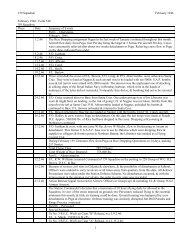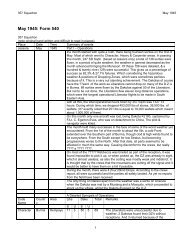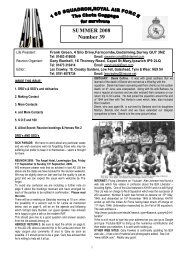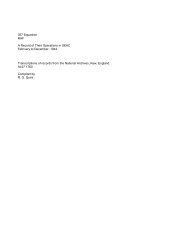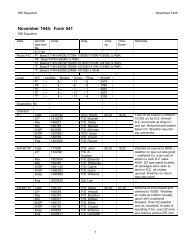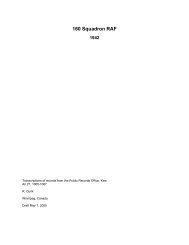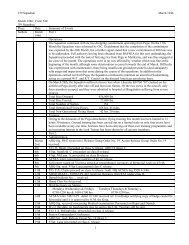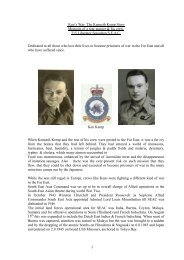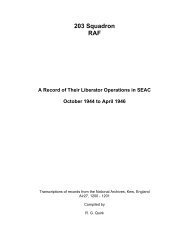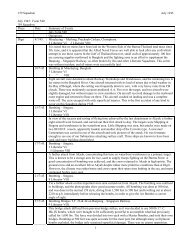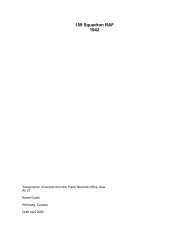RCAF Radar Personnel in WWII -North Atlantic Region-
RCAF Radar Personnel in WWII -North Atlantic Region-
RCAF Radar Personnel in WWII -North Atlantic Region-
Create successful ePaper yourself
Turn your PDF publications into a flip-book with our unique Google optimized e-Paper software.
<strong>North</strong> <strong>Atlantic</strong> <strong>Region</strong><br />
<strong>RCAF</strong> <strong>Radar</strong> <strong>Personnel</strong> <strong>in</strong> <strong>WWII</strong> <strong>North</strong> <strong>Atlantic</strong> <strong>Region</strong><br />
Background:<br />
When Germany <strong>in</strong>vaded Denmark and then Norway <strong>in</strong> April 1940, and rapidly acquired air and sea<br />
bases on the Norwegian coast right up to Cape <strong>North</strong>, the threat to Allied merchant shipp<strong>in</strong>g us<strong>in</strong>g<br />
the high latitude routes across the <strong>North</strong> <strong>Atlantic</strong> <strong>in</strong>creased significantly; and Scapa Flow, the Royal<br />
Navy’s home base <strong>in</strong> the Orkney Islands, was with<strong>in</strong> easy range of German long-range aircraft.<br />
Extension of ground radar cover northward and northeastward from Scotland became an urgent<br />
requirement, as witness a directive* issued by Churchill (then First Sea Lord) dated 16 April 1940:<br />
“ . . .you should now assume the duty of concert<strong>in</strong>g action to make the Faroes satisfactory for our<br />
purposes. Pray make a weekly report. DCNS will supply you with the requirements. We must have<br />
an aerodrome and RDF (radar) at the very earliest moment, together with AA defence, and a few<br />
coastal guns. This will be a very tempt<strong>in</strong>g base for a raid . . .”<br />
That particular directive dealt only with necessary action on the Faroes, but the need for additional<br />
radar cover based on the Orkneys and Shetlands was also recognized. The Inter-Services RDF<br />
Committee called for immediate placement of three additional CH (Cha<strong>in</strong> Home) radars on these<br />
two island groups, together with complementary CHL (Cha<strong>in</strong> Home Low) radars.<br />
Iceland too was of great concern to Allied planners. It was known that, prior to the outbreak of<br />
<strong>WWII</strong>, Germany had sent a large commission to Iceland to negotiate for air bases there.<br />
Fortunately, the Icelandic Cab<strong>in</strong>et had refused to grant any bases; nor would it allow German<br />
airl<strong>in</strong>es to establish ‘commercial routes.’ But with <strong>WWII</strong> underway, Germany was freed from the<br />
constra<strong>in</strong>t of “tipp<strong>in</strong>g its hand prematurely,” and Allied planners had to assume that German<br />
occupation of Iceland was imm<strong>in</strong>ent, with dire consequences for Allied trans-<strong>Atlantic</strong> shipp<strong>in</strong>g: the<br />
Allies would be denied potentially valuable bases from which to launch attacks on U-boats; and<br />
German long-range aircraft would be able to reach Allied convoys sail<strong>in</strong>g on routes previously<br />
threatened by only U-boats.<br />
Faced with this dangerous threat, Brita<strong>in</strong> acted with<strong>in</strong> a month of the German move <strong>in</strong>to Denmark,<br />
send<strong>in</strong>g a force of Royal Mar<strong>in</strong>es <strong>in</strong>to Iceland to forestall any German <strong>in</strong>vasion, at the same time<br />
pledg<strong>in</strong>g to respect Iceland’s <strong>in</strong>dependence. A similar treaty between the U.S.A and Iceland, made<br />
public <strong>in</strong> July 1941, enabled the U.S. to augment, and subsequently relieve British forces for service<br />
elsewhere.<br />
.<br />
* Churchill’s Second World War Vol . 1<br />
,9




